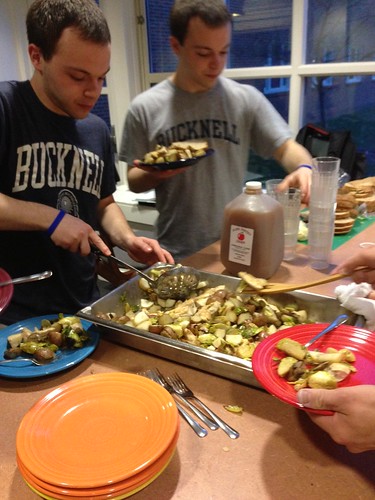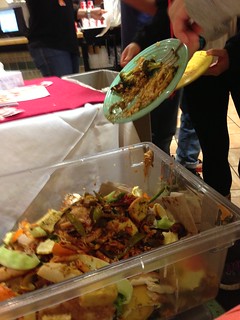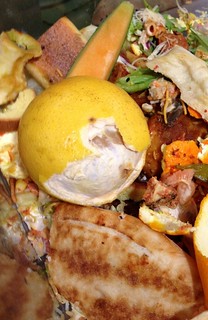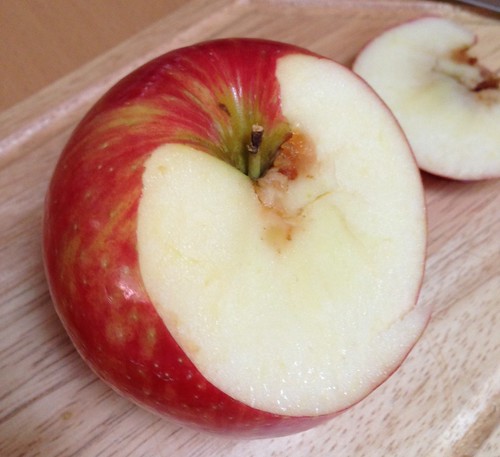As part of my visit to Bucknell University this week, I organized a Zero Waste Dinner for a group of interested students. The idea was to create a meal that would produce no waste of any kind–be it food, paper or plastic. In addition to enjoying what they cooked, teams of students were involved in the shopping, preparing, and cleaning.
At the planning meeting, we set the bar pretty high. In addition to no waste, we sought to make the meal as low-impact as possible. So that meant only cooking what was produced locally. And that, in turn, required a trip to the farmer’s market, which made it hard to plan ahead. The shopping team decided to play it by ear.
 The Lewisburg Farmers’ Market is not a growers market, providing another challenge. At this time of year, the majority of food for sale there comes from other states. That prompted a series of discussions with farmers about what they’d grown or raised, a useful experience for anyone, let alone students who’d never been to a farmers’ market.
The Lewisburg Farmers’ Market is not a growers market, providing another challenge. At this time of year, the majority of food for sale there comes from other states. That prompted a series of discussions with farmers about what they’d grown or raised, a useful experience for anyone, let alone students who’d never been to a farmers’ market.
We found locally grown mushrooms, potatoes, brussels sprouts, and turnips to roast together (in some delicious local butter sold to us by a friendly Mennonite dairy farmer, together with herbs from a campus garden).
There were plenty of apples on offer, which we decided to convert to apple sauce. If time or local flour were plentiful, it would have been a pie. We did buy a few loaves of bread from a Mennonite bakery (whose flour may or may not have been local; the answer was hazy enough to interpret it in our favor). Buying a dozen cookies from that same bakery seemed like the right thing to do, and then we found some apple cider for the beverage.
Unfortunately, the students were not too enthusiastic about a meat-free meal. That created the most trouble, prompting this dilemma:Â local vs. zero waste. The students wanted to make chicken and the only kind available was bone-in or whole birds. This wouldn’t have been too much of a problem if there was compost pile on campus hot enough to process meat and bones, but there isn’t. And we couldn’t imagine any students making stock from bones (certainly not with finals coming up!).

As a result, we sought chicken with as few bones as possible. There was a stand that had boneless breasts, but they were sold out (Murphy’s Law!). So we opted for the next best thing, breasts with the ribs attached. It wouldn’t be an ultimately zero waste dinner, but it would be darn close.
Because we had a few people cancel, we decided not to cook all of the food we’d bought. We set aside a portion of all of the vegetables to donate to the local soup kitchen, Community Harvest.
The food prep went smoothly, albeit slowly. The chopping and cooking was not without its hiccups, but they were minor ones. A few students who claimed to be complete amateurs in the kitchen improved dramatically and we produced a respectable meal for 12 in about two hours.
We decided to serve buffet style to allow people to take the amount and foods they wanted. And I encouraged people to feel comfortable going back to get more. Before starting, we took a moment to think about all that had gone into creating our meal–the growers’ efforts, the chicken’s life, our time and energy, the environmental impact. And, I’d venture to guess, most of us were quite thankful for that dinner.
 We ate slowly, mindfully, and then went back for seconds. The company and cider were enjoyed. New friends were made. Bellies were filled.
We ate slowly, mindfully, and then went back for seconds. The company and cider were enjoyed. New friends were made. Bellies were filled.
Next, Tupperware appeared. Leftovers were quickly divvied up–these are students after all–and dishes were washed. And then we brought to the compost bins at the campus garden that supplied the herbs. To top it all off, a huge lightning storm swept through as we were finishing up, illustrating the true power of a (nearly) zero waste meal.
 Apparently, the message is spreading. The stats:
Apparently, the message is spreading. The stats: Silliest waste: 3 packets of individually wrapped crackers that had to be throw away because a student took them on their plate. Sometimes health code rules are just silly.
Silliest waste: 3 packets of individually wrapped crackers that had to be throw away because a student took them on their plate. Sometimes health code rules are just silly. The Lewisburg Farmers’ Market is not a growers market, providing another challenge. At this time of year, the majority of food for sale there comes from other states. That prompted a series of discussions with farmers about what they’d grown or raised, a useful experience for anyone, let alone students who’d never been to a farmers’ market.
The Lewisburg Farmers’ Market is not a growers market, providing another challenge. At this time of year, the majority of food for sale there comes from other states. That prompted a series of discussions with farmers about what they’d grown or raised, a useful experience for anyone, let alone students who’d never been to a farmers’ market.
 We ate slowly, mindfully, and then went back for seconds. The company and cider were enjoyed. New friends were made. Bellies were filled.
We ate slowly, mindfully, and then went back for seconds. The company and cider were enjoyed. New friends were made. Bellies were filled.




